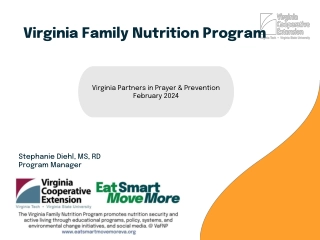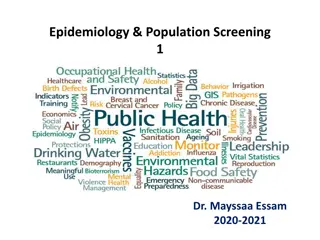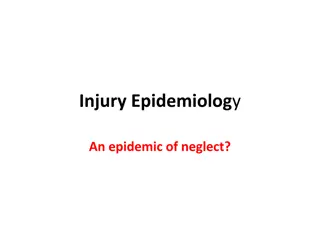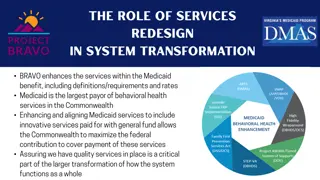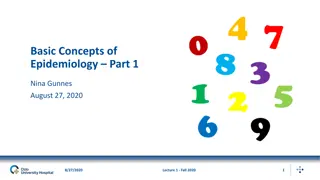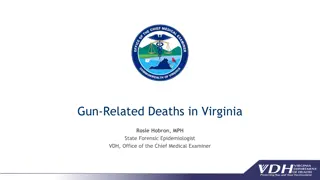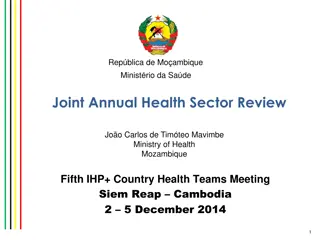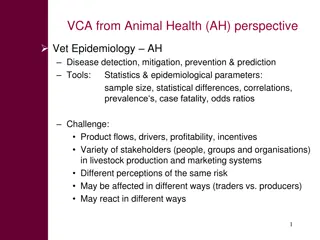Epidemiology Updates in Virginia's Health and Human Resources Sector
The presented data covers epidemiology updates, Zika virus testing, confirmed/probable Zika cases, CDC vital signs report on Zika pregnancy registry, and new CDC travel recommendations. Key points include testing statistics, case status breakdown by region and demographics, and recommendations for pregnant women and infants regarding Zika virus exposure.
Download Presentation

Please find below an Image/Link to download the presentation.
The content on the website is provided AS IS for your information and personal use only. It may not be sold, licensed, or shared on other websites without obtaining consent from the author.If you encounter any issues during the download, it is possible that the publisher has removed the file from their server.
You are allowed to download the files provided on this website for personal or commercial use, subject to the condition that they are used lawfully. All files are the property of their respective owners.
The content on the website is provided AS IS for your information and personal use only. It may not be sold, licensed, or shared on other websites without obtaining consent from the author.
E N D
Presentation Transcript
Virginia Secure Commonwealth Panel - Health and Human Resources Subpanel Epidemiology Updates Diane Woolard Division of Surveillance and Investigation Office of Epidemiology April 2017
Topic Outline Zika status Virginia and elsewhere Other Arboviral Diseases elsewhere Influenza Virginia and elsewhere Outbreak and case investigations Later Zika Epi plans and procedures, 2017
Testing Virginia Residents for Zika Virus Virginia Residents being Tested for Zika Virus Infection between 1/29/2016 and 3/31/2017* Disease Case Status Num % Virginia Residents being Tested by Region Confirmed/Probable Case 115 4 Not a case 2,349 90 4% 14% 9% Test results pending 162 6 Central Eastern 16% Sex and Pregnancy Status Num % Northern Northwest Male 292 11 Southwest Female 2,334 89 56% Pregnant 2,077 89 Non-pregnant 257 11 *This excludes 154(6%) Virginia residents who were approved for, but then declined testing. Case status is based on CSTE s revised interim case definitions. If pregnancy status was unknown, then pregnancy status was classified as non-pregnant.
Testing Virginia Residents for Zika Virus Virginia Residents being Tested for Zika Virus Infection between 1/29/2016 and 3/31/2017* Confirmed or Probable Zika Virus Disease Cases Number of Virginia Residents being Tested by Confirmed/Probable Zika Disease Case Status CDC recommended testing asymptomatic pregnant women with possible exposure VDH expanded testing for travelers and local transmission 7 6 5 0 6 4 0 3 2 16 6 7 4 *This excludes 154(6%) Virginia residents who were approved for, but then declined testing. Case status is based on CSTE s revised interim case definitions.
CDC Vital Signs Report 4/4/17 US Zika Pregnancy Registry data - 1,297 women Birth defects in 10% completed pregnancies with confirmed Zika infection Up to 15% for those infected in 1st trimester Postnatal neuroimaging in 25% and Zika testing of at least one infant specimen in 65% Pregnant women should avoid Zika virus exposure; infants need imaging and testing
New CDC Travel Recommendations CDC now recommends that pregnant women not travel to any area where there is a risk of Zika virus infection (ongoing, endemic, likely/undocumented). Pregnant women exposed to an area with a CDC Zika travel notice should be tested for Zika, regardless of symptoms. Pregnant women exposed to an area with Zika risk but no CDC Zika travel notice should be tested for Zika 1) if they have symptoms or 2) if their fetus has abnormalities that may be related to Zika on ultrasound.
CDC Country Classification Categories developed by WHO, adopted by CDC Category 1: Area with new introduction or re-introduction with ongoing transmission Category 2: Area with evidence of virus circulation before 2015 or area with ongoing transmission that is no longer in the new or re-introduction phase, but where there is no evidence of interruption Category 3: Area with interrupted transmission and with potential for future transmission Category 4: Area with established competent vector but no known documented past or current Zika virus transmission https://www.cdc.gov/zika/geo/country-classification.html Area with a Risk of Zika mean categories 1, 2, and 4 Travel Notices ( practice enhanced precautions ) for categories 1 and 2
Zika travel notices indicate Zika in a place where it has not been before or an increase in cases above what that country usually reports, not an increased risk as compared to countries without a travel notice.
US Zika Data January 1, 2015 April 5, 2017 5,197 Zika virus disease cases reported 4,901 (94%) in travelers returning from affected areas 222 cases acquired through presumed local mosquito- borne transmission in Florida (N=216) and Texas (N=6) 74 cases acquired through other routes, including sexual transmission (N=45), congenital infection (N=27), laboratory transmission (N=1), and person-to- person through an unknown route (N=1)
Zika Activity Summary FL and TX only states with areas of local transmission; travel advisories apply only to affected counties PAHO: Some countries increasing, some decreasing, some stable Zika activity WHO: vigilance needs to remain high Risk in US travelers expected to continue, but potentially decrease and change with seasons Local transmission in US might occur Surveillance & testing can increase case counts
Other Emerging Arbovirus Yellow fever in Brazil: outbreak since Dec 2016 with over 1,500 cases reported (~400 confirmed). Vaccination against yellow fever is recommended for travelers to affected areas in the States of Rio de Janeiro and S o Paulo in Brazil. Avoid mosquitoes. Last case of yellow fever in VA was in the 1800s
Avian Flu in the US Highly pathogenic H7N9 avian influenza in commercial chicken flock in TN first of the year In Mississippi flyway, not Atlantic Rapid response to contain the spread - Quarantine/depopulate birds; enhanced surveillance/testing Low path H7N9 flu virus detected in flocks in other states
Novel Flu in China H7N9 influenza outbreak in China. Genetically different virus from the HPAI in TN. Over 400 cases since October severe disease Likelihood in US is low No evidence of sustained human-to-human spread (necessary for a pandemic)
Emerging Healthcare-Associated Infections Candida auris - new superbug emerging worldwide. Identified in interconnected hospitals and nursing homes in three states. Multiple introductions of C. auris into the US have likely occurred. Controlled with rigorous tracking and infection control. Carbapenem resistant bacteria - CDC establishing a network of labs. Suspected carbapenem-resistant Enterobacteriaceae (CRE) and Pseudomonas aeruginosa isolates are tested at the state/local level; any with suspected novel resistance will be sent to regional labs. mcr-1 another form of drug resistance - mostly associated with travel. Mostly found in E. coli. No transmission has been identified, and it generally has a limited duration of intestinal colonization. Intensive investigations occur around each reported case
Case Investigations - Virginia Volume & Trend of Selected Conditions Trend in hepatitis C chronic infections 2500 12000 10000 2000 8000 1500 Campy Hep B 6000 Hep C Lead Lyme 1000 4000 500 2000 0 0 2007200820092010201120122013201420152016 2007200820092010201120122013201420152016
Preparing for Changes Changing lab tests increased use of rapid detection tests (not culture) affects our work Changing technology new electronic ways to receive a lot more information Emerging conditions These things, and others, keep us awake at night and on our toes We are working to detect and respond effectively


